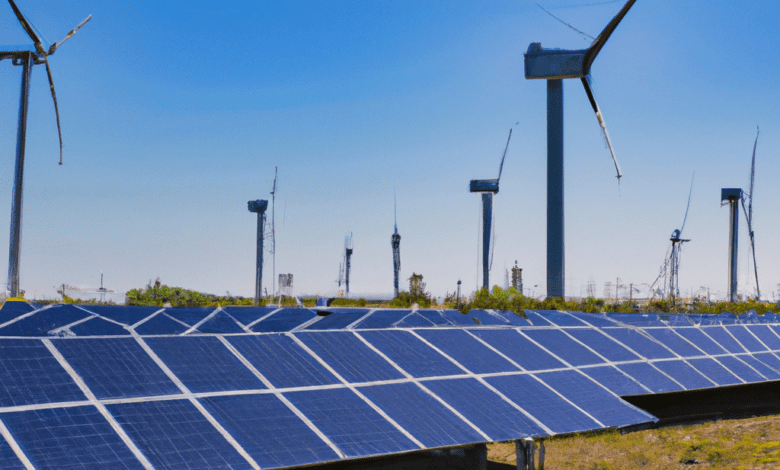Powering the Future: The Surge of Renewable Energy Through Solar, Wind, and Hydrogen Innovations

As the world grapples with the urgent need to address climate change and transition to sustainable energy systems, the rise of renewable energy sources has become a beacon of hope for a more sustainable future. Among these sources, solar, wind, and hydrogen power are leading the charge, each offering unique advantages and transformative potential. Solar energy technologies are experiencing unprecedented growth, harnessing the sun's abundant rays to generate clean electricity. Meanwhile, wind power is sweeping across landscapes, reshaping the way we think about energy production and consumption. Additionally, the burgeoning hydrogen economy is unlocking new possibilities for clean fuel sources that could revolutionize transportation and industry. In this article, we will explore the remarkable advancements in these three renewable energy sectors, highlighting their contributions to a greener planet and the challenges that lie ahead in our quest for a sustainable energy future. Join us as we delve into the innovations and implications of harnessing the sun, the winds of change, and the promise of hydrogen fuel.
- 1. **Harnessing the Sun: The Rapid Growth of Solar Energy Technologies**
- 2. **Winds of Change: How Wind Power is Transforming the Energy Landscape**
- 3. **The Hydrogen Revolution: Unlocking the Potential of Clean Fuel Sources**
1. **Harnessing the Sun: The Rapid Growth of Solar Energy Technologies**
In recent years, solar energy has emerged as a cornerstone of the global transition to renewable energy, driven by rapid advancements in technology, decreasing costs, and increasing awareness of the environmental impacts of fossil fuels. The ability to harness the sun’s energy is not a new concept, but the last decade has seen a remarkable acceleration in the development and deployment of solar technologies, making it more accessible and efficient than ever before.
Photovoltaic (PV) cells, which convert sunlight directly into electricity, have experienced significant improvements in efficiency and affordability. Innovations in materials, such as the development of perovskite solar cells, have the potential to further increase efficiency rates while reducing production costs. These advancements enable solar panels to generate more power from the same amount of sunlight, making solar installations more economically viable for both residential and commercial applications.
The global solar market has witnessed exponential growth, with installed capacity skyrocketing from around 40 gigawatts (GW) in 2010 to over 1,000 GW by 2020. This growth can be attributed to supportive government policies, subsidies, and incentives that encourage investment in renewable energy. Additionally, the increasing competitiveness of solar energy against traditional fossil fuels has led to a surge in private sector investment, further accelerating the adoption of solar technologies.
Decentralized solar power systems, such as rooftop installations and community solar projects, are democratizing energy access, allowing homeowners and businesses to generate their own electricity. This shift not only reduces energy bills but also enhances energy security and resilience, especially in regions where grid infrastructure is lacking or unreliable. As battery storage technology continues to advance, the ability to store excess solar energy for use during non-sunny periods further enhances the reliability and appeal of solar power.
Moreover, the integration of solar energy into smart grids is transforming the way energy is consumed and managed. Innovations in energy management systems facilitate real-time monitoring of energy production and consumption, enabling more efficient use of solar power. This integration is crucial for creating a sustainable energy ecosystem that maximizes the benefits of renewable energy sources.
As the world grapples with climate change and strives to reduce carbon emissions, the rapid growth of solar energy technologies stands as a beacon of hope. By harnessing the sun’s abundant power, we have the opportunity to create a cleaner, more sustainable future—one where energy is not only renewable but also accessible to all. With continued investment, innovation, and supportive policies, the solar energy sector is poised to play a pivotal role in the global energy landscape for decades to come.
2. **Winds of Change: How Wind Power is Transforming the Energy Landscape**
Wind power has emerged as a cornerstone of the renewable energy revolution, significantly transforming the energy landscape across the globe. As technology advances and the urgency to combat climate change intensifies, wind energy is gaining traction as a viable and sustainable alternative to fossil fuels. With the potential to harness the natural, inexhaustible currents of air, wind power offers a clean, efficient, and economically competitive solution to meet growing energy demands.
One of the most notable aspects of wind energy is its scalability. Wind farms can be established in various settings, from large offshore installations that harness the powerful gusts over oceans to smaller onshore turbines that benefit rural communities. This versatility allows for localized energy production, reducing transmission losses and bolstering energy security. Countries like Denmark and Germany have set ambitious targets, integrating wind energy as a substantial part of their national grids, and showcasing the potential for widespread adoption.
Moreover, advancements in turbine technology have significantly increased efficiency and reduced costs. Modern turbines are larger and more powerful, capable of generating electricity even in low-wind conditions. Economies of scale and improvements in manufacturing processes have driven down the cost of wind energy, making it one of the cheapest sources of new electricity in many regions. According to the International Renewable Energy Agency (IRENA), the cost of onshore wind power has fallen by nearly 50% over the last decade, making it a competitive player in the global energy market.
The environmental benefits of wind power further bolster its appeal. Unlike fossil fuel-based energy sources, wind energy produces no air pollutants or greenhouse gas emissions during operation. This clean energy source plays a crucial role in mitigating climate change and improving air quality, which has direct health benefits for communities. As nations strive to fulfill their commitments under international climate agreements, wind power will be instrumental in achieving carbon neutrality and transitioning to a sustainable energy future.
However, the rise of wind power is not without challenges. Concerns regarding land use, wildlife impacts, and aesthetic considerations have sparked debates in communities where wind farms are proposed. Additionally, the intermittent nature of wind energy necessitates advancements in energy storage and grid management to ensure a reliable power supply. Despite these challenges, the benefits of wind power far outweigh the drawbacks, and ongoing research and innovation continue to address these issues.
In conclusion, wind power is undeniably a driving force in the transition toward a greener energy landscape. As technology continues to evolve and costs decline, wind energy is poised to play an increasingly pivotal role in meeting global energy needs sustainably. By embracing the winds of change, societies around the world can move closer to a clean, renewable energy future, one turbine at a time.
3. **The Hydrogen Revolution: Unlocking the Potential of Clean Fuel Sources**
The hydrogen revolution represents a significant shift in how we think about clean fuel sources and energy storage. As the world grapples with the impacts of climate change and the urgent need to reduce greenhouse gas emissions, hydrogen emerges as a versatile and abundant element that can play a pivotal role in the global energy transition. Unlike fossil fuels, when hydrogen is used as a fuel, it produces only water as a byproduct, making it an attractive option for decarbonizing various sectors, including transportation, industry, and power generation.
One of the most promising methods for producing hydrogen is through electrolysis, where electricity—preferably sourced from renewable energy like solar or wind—is used to split water into hydrogen and oxygen. This process can create "green hydrogen," which is considered the cleanest form of hydrogen available. As the cost of renewable energy continues to decline, the economic feasibility of producing green hydrogen is improving, making it a viable alternative to traditional fossil fuels.
The versatility of hydrogen extends beyond just being a fuel. It can be stored and transported more easily than electricity, making it a key player in addressing the intermittency challenges of renewable energy sources. Hydrogen can be stored in large quantities, allowing excess energy generated during peak production times to be converted into hydrogen, which can then be used during periods of low energy generation. This capability not only enhances energy security but also facilitates the integration of renewable energy into existing energy systems.
Moreover, hydrogen has the potential to decarbonize heavy industries that are notoriously difficult to electrify, such as steel and cement production. By replacing carbon-intensive fuels with hydrogen, these industries can significantly reduce their carbon footprints. Additionally, hydrogen fuel cells are being developed for various applications, including zero-emission vehicles and public transportation, offering a sustainable alternative to conventional gasoline and diesel engines.
Governments and private sector players worldwide are recognizing the potential of hydrogen, leading to an increased investment in research, infrastructure, and technology development. Initiatives aimed at scaling up hydrogen production and creating a hydrogen economy are gaining traction, with countries like Germany, Japan, and Australia at the forefront of these efforts.
In summary, the hydrogen revolution holds immense promise as a clean fuel source that can complement the ongoing expansion of solar and wind energy. By harnessing hydrogen's potential, we can move towards a more sustainable, low-carbon future, creating a robust energy system that not only meets current demands but also safeguards the environment for generations to come.
In conclusion, the rise of renewable energy is not just a trend but a transformative movement reshaping our global energy landscape. Solar energy technologies have seen remarkable advancements, making clean energy more accessible and efficient than ever before. Wind power continues to gain momentum, harnessing natural forces to provide sustainable electricity while reducing our reliance on fossil fuels. Meanwhile, the hydrogen revolution holds immense promise, offering a versatile and clean fuel alternative that could power everything from vehicles to industries.
As we stand at the crossroads of a new energy era, it is crucial for governments, businesses, and individuals to embrace and invest in these renewable technologies. The collective transition to solar, wind, and hydrogen power not only addresses pressing environmental challenges but also fosters economic growth, job creation, and energy independence. By prioritizing and supporting these innovations, we can build a sustainable future that not only meets our current energy demands but also safeguards our planet for generations to come. The path to a cleaner, greener world is illuminated by the sun, propelled by the wind, and fueled by hydrogen—let us seize this opportunity to drive meaningful change.





